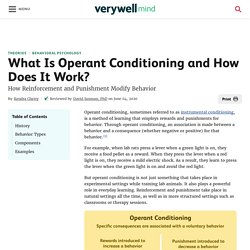

Therefore, parents are exposed to reinforcement and punishment which are seen as positive parenting tools to regulate their teenager's behaviors instead of utilizing a single method only. What Is Operant Conditioning and How Does It Work? Operant conditioning, sometimes referred to as instrumental conditioning, is a method of learning that employs rewards and punishments for behavior.

Through operant conditioning, an association is made between a behavior and a consequence (whether negative or positive) for that behavior.1 For example, when lab rats press a lever when a green light is on, they receive a food pellet as a reward. Image01. Positive Reinforcement. Negative Reinforcement. Difference Between Positive and Negative Reinforcement. Positive and Negative Reinforcement Underlying Risk Behavior in Early Adolescents.
Schedules Of Reinforcement - Psychology. Schedules of reinforcement can affect the results of operant conditioning, which is frequently used in everyday life such as in the classroom and in parenting.

Let’s examine the common types of schedule and their applications. Schedules Of Reinforcement Operant conditioning is the procedure of learning through association to increase or decrease voluntary behavior using reinforcement or punishment. Schedules of reinforcement are the rules that control the timing and frequency of reinforcer delivery to increase the likelihood a target behavior will happen again, strengthen or continue. A schedule of reinforcement is a contingency schedule.
Schedules of Reinforcement. Learning: Schedules of Reinforcement. The Study of Punishment in Psychology. Punishment is a term used in operant conditioning to refer to any change that occurs after a behavior that reduces the likelihood that that behavior will occur again in the future.

While positive and negative reinforcements are used to increase behaviors, punishment is focused on reducing or eliminating unwanted behaviors. Punishment is often mistakenly confused with negative reinforcement. The difference: Reinforcement increases the chances that a behavior will occur and punishment decreases the chances that a behavior will occur. Types of Punishment Behaviorist B. Punishment. Positive and negative punishment. Learning: Negative Reinforcement vs. Punishment. Influencing behavior. 12 Examples of Positive Punishment & Negative Reinforcement.
You might be thinking that “positive punishment” sounds like an oxymoron, after all, how can punishment be positive?

Not many people “like” punishment, right? The disconnect in understanding this concept comes from the usage of the word “positive;” here at PositivePsychology.com, we generally use the term “positive” to refer to things that are inherently good, things that are life-giving, and things that promote thriving and flourishing. The concept of positive punishment comes from a very different era and a very different perspective on psychology; namely, the 1930s and behaviorism. So, what actually is positive punishment and how does it relate to parenting, teaching, and even the workplace?